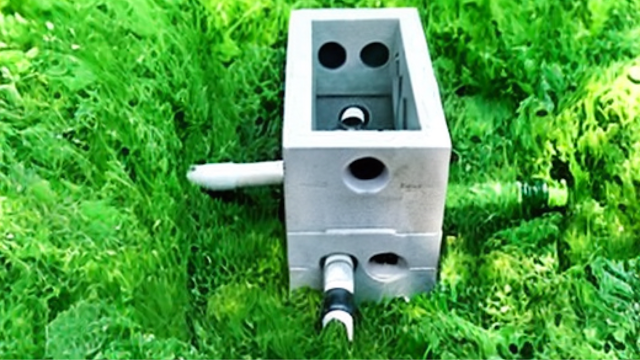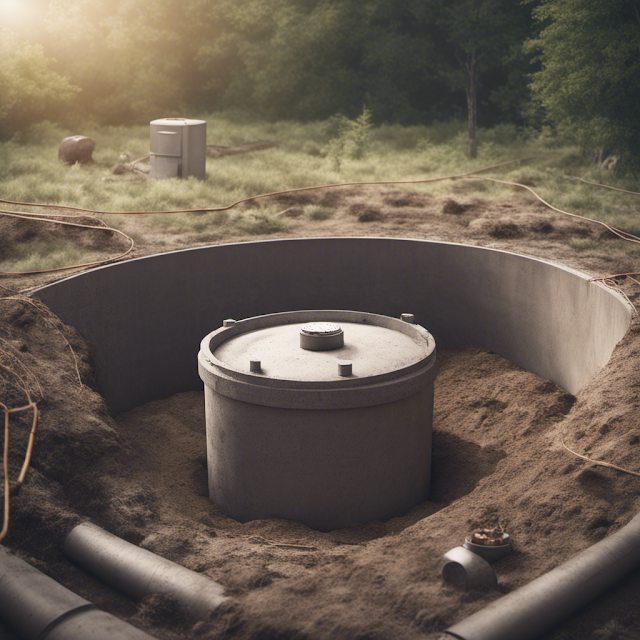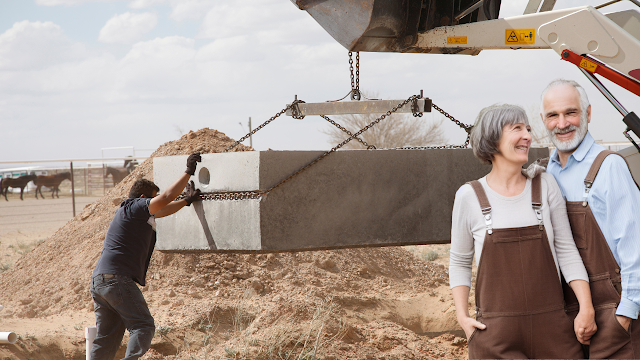How To Identify And Address A Leaking Septic Tank
 |
| Leaking septic tank |
As a homeowner, it's important to be
aware of potential septic tank problems. A leaking septic tank can cause
extensive damage to your property and the environment, so it's essential to
identify and address any issues promptly.
In this article, I'll provide an overview
of the signs of a leaking septic tank, explain how you can conduct a visual
inspection and check for foul odors, give guidance on monitoring slow drains
and backups, examine the drainfield area, assess the groundwater level in
relation to the tank location, discuss hiring a professional inspector if
needed, outline how to repair or replace a leaking tank, and provide advice on
preventive maintenance for a healthy system.
Key Takeaways
•
Conduct a visual inspection to
look for signs of a leaking septic tank, such as damp patches in the lawn and
foul odors.
•
Monitor the frequency of septic
tank pumping and the sludge level to prevent further damage and contamination.
•
Perform a dye test using
fluorescent dye tablets to confirm drainage problems in the septic tank and
drainfield.
•
Regularly assess groundwater
levels and water flow to determine if the septic system is functioning properly
and to prevent clogging and flooding of drains.
Signs of a Leaking
Septic Tank
If you're noticing damp patches in your lawn or a foul smell coming
from your yard, it's likely that your septic tank is leaking! Leaking septic
tanks are a common issue for homeowners and can be difficult to identify. To
make sure the problem is properly addressed, there are several warning signs
you should look out for.
One of the most obvious signs of a septic tank leaking is when water
pools up near where the tank was installed. This could also be accompanied by
an unpleasant odor. If these issues are present, then it's time to take action
and find out what's causing them.
Another sign to watch out for is if plants start to die around the
area where the tank was installed. The bacteria in a leaking septic tank can
cause plant life in the surrounding area to become unhealthy or die off
completely, so keep an eye on any plants nearby as well.
Finally, check for any damage done to your property due to a septic
tank leak. Damage caused by leaks can range from structural damage such as
cracks in walls and foundations, all the way down to warping floors or
discoloration on surfaces due to mold growth caused by stagnant water buildup
near the leak source. All of these issues indicate that something isn't right
with your system and should be addressed immediately before they become worse
over time.
It's important to pay attention for any signs of a leaking septic
tank so that it can be addressed quickly and effectively before further damages
occur or health risks arise from exposure to contaminated wastewater runoff, check the regulations with the USA environmental gov site.
Now that we know some warning signs of this issue, let's move onto conducting a
visual inspection of our system and looking into potential causes behind this
frustrating problem!
Conducting a Visual
Inspection
Take a look around your property and see if you can spot anything
suspicious. Is there grass or other vegetation that's greener, taller, or
growing faster than the rest? Are there any puddles of standing water near the
septic tank? These are potential red flags that indicate leakage.
To get a better idea of what's going on beneath the ground, you may
want to inspect your system visually.
Start by examining the lid of the septic tank for signs of damage or
wear and tear. If it's bowed outwards, this could indicate that pressure is
building up inside due to excess wastewater. Also, check for corrosion around
areas where fittings join pipes together – they should be sealed airtight with
no visible gaps.
When inspecting underground pipes and drains, look out for wet
patches on the ground as well as damp spots on walls. If you come across a
plumbing fixture like a sink or toilet that's slow to empty waste water, this
could be caused by a blockage in the line due to seepage from a cracked pipe
further down. Lastly, pay attention to any changes in color or texture in thesoil surrounding your system – it should normally appear dry and crumbly rather
than soggy or muddy-looking.
This visual inspection should provide you with some clues about
whether your septic tank is leaking and needs immediate repair work. Now, all
that remains is to check for foul odors coming from nearby sources – an
unpleasant but necessary step in assessing any potential leaks!
Checking for Foul Odors
See if you can detect any unpleasant smells coming from the area, as
this could be a sign of a septic system issue. Foul odors are one of the most
common indicators that there's something wrong with your septic tank or drain
field.
If you've noticed any unusual scents in the surrounding area, it's important
to take action right away and investigate further. The most common culprits for
foul odors are sewage gases like hydrogen sulfide and methane, which can be
hazardous for humans and animals alike. These gases are produced by bacteria
breaking down organic matter in anaerobic conditions, so they may be present
even when a tank isn't leaking. However, if the smells persist despite regular
maintenance of the septic system, then there could be an underlying problem
that needs to be addressed.
To determine whether or not your septic tank is leaking due to these
gases, you should first contact a professional plumber or septic service
technician who can conduct further testing and inspections. They'll often use
special tools like infrared cameras and gas sniffers to identify where the
leaks are located and what type of repairs need to be made.
You should also check around your house for other signs that
indicate a potential leak in your septic system, such as wet spots on lawns or
soil that appears soggy or saturated near the tank itself. Additionally, listen
out for gurgling sounds coming from drains inside the home - this could
indicate backed-up pipes caused by blockages in the main line leading into your
house from outside sources like tree roots growing into them over time.
Once all possible sources of odor have been identified and
inspected, it's time to move onto monitoring slow drains and backups - another
telltale sign of an issue with your septic system that requires immediate
attention.
 |
| foul odors |
Monitoring Slow
Drains and Backups
When slow drains and backups occur, it can be a sign of trouble
lurking within the plumbing system. It's important to take note of any slow
drainage in sinks, showers, and toilets as these are all indicators that there
could be an issue with your septic tank.
If you have a sewage backup in your home, this is an even more
pressing issue. You should immediately contact a professional to investigate
what the underlying cause may be.
It's also important to keep tabs on how often you need to pump out
your septic tank. If it seems like you're having to pump out more frequently
than usual, or if the sludge level appears higher than normal upon inspection,
then this too could be an indication that something is wrong with the tank itself.
A leaky septic tank can cause all kinds of problems such as groundwater
contamination and structural damage if not addressed quickly enough.
You might also want to check around the drainfield area for signs of
wetness or standing water which could indicate a leak in one or more parts of
the system. Any unusual smells present near the drainfield area should also be
investigated as they could point towards some kind of blockage or other problem
with your system.
If any issues do arise during monitoring or inspection, you should
contact a certified septic system installer right away who will be able to
assess whether repairs are needed or not. Be sure to ask plenty of questions so
that you understand exactly what needs fixing and why - taking action early can
help save time and money in the long run! Taking steps now will ensure that
your septic tank continues running smoothly and safely into the future without
leaking wastewater into areas where it doesn't belong.
Examining the drainfield area is another step necessary for
identifying potential problems with a leaking septic tank before they become
too serious and costly to repair.
Examining the
Drainfield Area
Investigating the drainfield area is imperative for preemptively
detecting any potential issues that could arise from a faulty septic system.
It's important to note that while some signs of a failing system might be
visible, others will require more in-depth testing and inspection.
To begin, start by visually inspecting the soil around the
drainfield area for any wet patches or water pooling on top. This can indicate
an over-saturated field due to too much wastewater entering the soil faster
than it can be absorbed. Additionally, look for any standing water near the
septic tank itself as this could suggest a damaged or cracked pipe leading out
of it.
Next, check for any odors around the drainfield area which are often
caused by gasses emitted from decaying waste in the ground. If there's an
unpleasant smell coming from this area, it may be indicative of a sewage leak
directly into the soil or nearby groundwater source.
Finally, inspect if there are any changes in vegetation growth such
as lush green grass even when other plants aren't growing well; this could mean
that excess nutrients from untreated wastewater are feeding these plants
instead.
These visual and olfactory observations should paint a clear picture
whether there's evidence of leakage in your septic system or not. If so,
further steps must then be taken to address it appropriately before it leads to
disastrous consequences.
Performing a dye test is one way to confirm drainage problems within
your septic tank and drainfield so you can take corrective action quickly and
efficiently.
Performing a Dye Test
Now that we've examined the drainfield area, it's time to perform a
dye test. This test will help us identify where exactly the septic tank may be
leaking. It's important to note that this test should only be done when there
aren't any heavy rains in the forecast, or it could interfere with the results.
To conduct a dye test, you'll need to first get some fluorescent dye
tablets from your local hardware store. The next step is to drop one tablet
into each of the drains in your house and then wait for about 15 minutes. After
enough time has passed, go outside and look at all of your drains and seepage
pits around your property for any fluorescence coming from the dye tablets. If
you see any bright green or yellow fluid coming from any of these areas, that
would indicate that there's a leak somewhere in your system.
Once you've identified where specifically on your property you
suspect a leak may be occurring, it's important to take action quickly. You can
start by digging up small sections of soil near where you noticed the leakage
so that you can inspect the pipes for signs of damage such as cracks or
openings that are allowing water to pass through them instead of staying
contained within the pipe walls as intended. If needed, repairs can be made
using epoxy paste or other sealants available at most home improvement stores.
Finally, don't forget to regularly monitor your septic tank levels
by having it pumped out every two years or so depending on how many people live
in your household and what size tank you have installed on-site. This way, if
there ever happens to be an issue with leakage again in the future, it won't go
unnoticed until too much damage has been done!
Now let's move on to assessing groundwater levels, which can also
provide further insight into whether or not our tank is leaking properly.
Assessing the
Groundwater Level
Assessing the groundwater level can provide valuable insights into
whether or not a system is functioning properly, so it's important to monitor
it regularly.
Using a long-handled tool such as a soil auger to measure the amount
of water in the soil around your septic tank and drainfield will help you
determine whether there is an issue with over saturation or ponding on the
surface. You should also observe where water flows in relation to your tank and
lines when it rains, due to potential blockages or infiltration issues. If you
notice any changes such as pooling near your septic system, this could be an
indicator of a problem with your system.
In order to accurately assess the groundwater level around your tank
and drainfield, you must take measurements at different depths throughout the
area. Take measurements at least three times: once at the top of the drainage
field, once in the middle, and once at its bottom. If there are significant
differences between these readings then you may have an issue with infiltrating
ground water that needs further investigation.
If you find that there is too much ground water present around your
tank or lines, then this could potentially lead to problems if left unchecked.
The excess moisture can cause standing water on top of your lines which can
lead to clogging and flooding of drains within the home. It can also reduceabsorption into surrounding soils which means less nutrients are filtered out
before entering nearby waterways which causes pollution issues for local
ecosystems.
As such, assessing groundwater levels are essential for identifying
potential problems before they become more serious – making sure that
everything functions correctly and minimizing environmental impact from
improper wastewater management practices. Taking proactive steps now will serve
you well in ensuring proper operation of your septic system for years to come -
transitioning seamlessly into hiring a professional septic inspector who can
provide even more detailed analysis of any potential issues found during
assessment.
Hiring a
Professional Septic Inspector
If you're noticing any issues with your septic system, it's best to
hire a professional septic inspector to get a thorough analysis. A qualified
inspector can provide an accurate assessment of the current condition of your
tank and piping, as well as identify any potential problems that may be causing
the leak or other issues.
This type of inspection is also very important if you need to assess
any potential hazards caused by a leaking tank.
When hiring an inspector, it's important to make sure they're
licensed and have experience in dealing with situations similar to yours. Ask
for references from previous customers who were happy with their service and
check with local authorities like your city's sewer department for
recommendations. Also, inquire about their fees so there are no surprises after
the job is done.
It's also important that the inspector performs a complete
evaluation of your system, including checking for necessary repairs or
replacements that could be needed as part of the process. This step should
include testing all parts of the septic system including pipes, tanks, drains,
pumps, and other components. The inspector should also take detailed notes on
their findings so they can explain them clearly when presenting their report
back to you.
In addition to assessing existing damage, an experienced inspector
will be able to identify potential risks associated with having a leaking tank,
such as contamination of groundwater or nearby streams, which could pose
serious health risks if not addressed properly. By hiring a professional septic
inspector before attempting any repairs on your own, you can ensure that all
safety precautions are taken throughout the process while helping avoid costly
mistakes down the road.
With this information in hand, you'll be better prepared to move
forward with repairing or replacing your leaking tank efficiently and safely.
Repairing or
Replacing a Leaking Tank
Once your professional septic inspector has completed their
evaluation, you'll need to decide whether repairing or replacing your system is
the best option. If the tank itself is leaking, then it's likely that you'll
need to replace it. On the other hand, if there are just some minor issues with
pipes and connections, then it might be possible to repair them without having
to replace the entire system.
It's important to remember that when making this decision you should
consider factors like cost and how long a repair will last compared to a
replacement.
When deciding on repairs, also keep in mind what type of damage has
been done by the leak. Some types of damage may require more extensive repairs
than others. Additionally, certain materials may not be suitable for certain
conditions or locations. For example, plastic tanks may need to be replaced
sooner than concrete tanks due to environmental factors like temperature
fluctuations or exposure to water and sunlight.
The best way to determine what repairs are needed is by consulting
with an experienced septic technician who can evaluate your system and make
recommendations based on their experience. They should also have access to any
necessary parts needed for the job as well as give you an estimate of how much
it will cost before proceeding with repairs or replacement.
When selecting a contractor for this work, make sure they have
experience in both installation and maintenance of septic systems so they can
provide quality service from start-to-finish. A good contractor will also offer
a warranty on their work so that if something goes wrong down the road after
they've finished working on your system, they'll be able to come back out and
fix it for free or at no additional cost beyond what was initially agreed upon
upfront.
Now that you know about repairing or replacing your leaking septic
tank, next comes preventive maintenance for keeping a healthy system over time
- something all homeowners should strive for!
Preventive
Maintenance for a Healthy Septic System
The previous subtopic discussed the approaches to repair or replace
a leaking septic tank. Preventive maintenance for a healthy septic system is
just as important, if not more so. This will help keep your tank in good
condition and avoid expensive repairs or replacements down the road.
When it comes to preventive maintenance, there are some key steps
you should take to ensure that your system remains in top condition. To start,
you need to have regular pump-outs of the tank done by a professional plumber
every three to five years. During these visits, they can also check for any
signs of wear or damage and make necessary repairs if needed.
You should also be mindful of what goes into your septic tank and
avoid flushing any non-biodegradable items like condoms, plastic bags,
cigarette butts, etc., as this can clog up the pipes and cause issues with
proper functioning over time. If you have a garbage disposal unit installed in
your kitchen sink, be sure to use it sparingly as large amounts of food waste
will create an overload on your system.
It's best practice to add bacteria supplements regularly, which
helps break down solid waste buildup and prevent blockages from happening in
the first place.
Finally, look out for signs that something may be wrong with your
system, such as water pooling on the surface around where it was installed, bad
odors coming from drains inside your home or yard, etc. These can all indicate
possible problems with the system itself, so contact a professional right away
if anything seems off.
Taking care of your septic system with regular maintenance is
essential for keeping it running efficiently while avoiding costly repairs or
replacements down the line. By following these few simple tips, you can make
sure that everything is working properly - now and for many years to come!
Frequently Asked
Questions
How much does it
cost to repair or replace a leaking septic tank?
The
cost to repair or replace a leaking septic tank depends on the damage.
Generally, repairs can range from hundreds to thousands of dollars while a full
replacement may be five times that amount.
What type of
preventive maintenance should be done to keep a septic tank healthy?
I
recommend regularly inspecting and cleaning the septic tank, as well as having
a professional inspect it annually. Additionally, use water conservation
measures to reduce strain on the system.
How often should
a professional septic inspector be hired?
I
recommend hiring a professional septic inspector at least every 3-5 years to
assess the health of your tank. Doing so will help identify any problems before
they become serious.
How can I tell
if the groundwater level is being affected by a leaking septic tank?
I
can check for changes in the groundwater level around the septic tank. If I
detect a change, it may indicate leaking from the tank and should be addressed
immediately.
Can I do the
repairs or replacement of a leaking septic tank myself?
I
can do some repairs myself, but it's best to hire a professional for a septic
tank replacement. They'll have the experience and expertise to get it done
quickly and safely.
.png)



.png)






Comments
Post a Comment